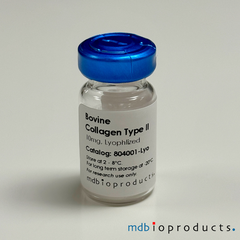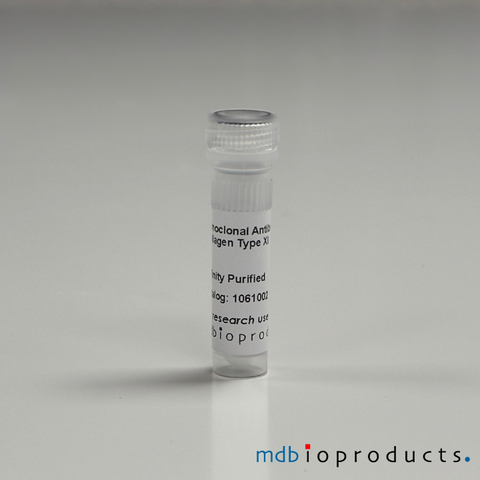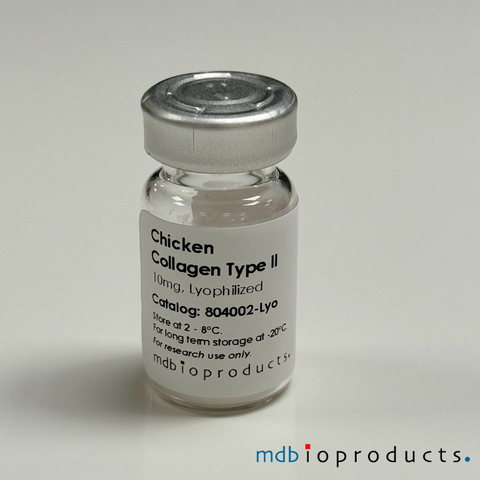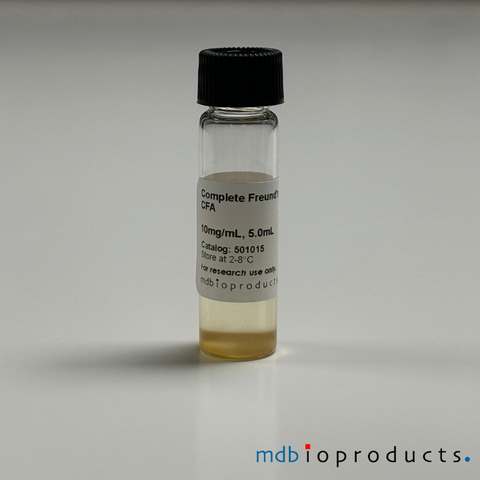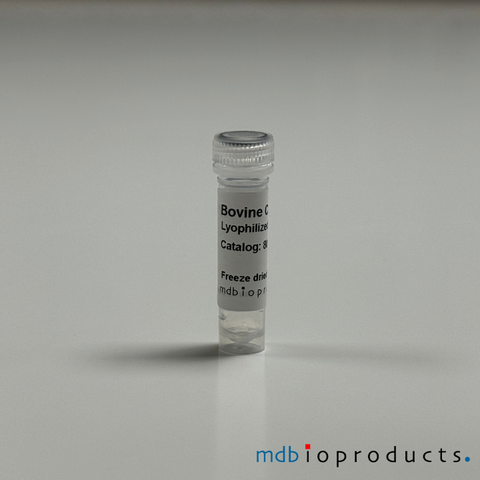Collagen Type II, Bovine, Immunization Grade, Lyophilized, 10 mg
Immunization Grade Collagen type II (CII) protein, purified from fetal bovine articular cartilage, for the induction of arthritis in the Collagen-Induced Arthritis (CIA) model. Type II collagen (CII) is a fibrillar...
Protein
804001-lyo
Immunization Grade Collagen type II (CII) protein, purified from fetal bovine articular cartilage, for the induction of arthritis in the Collagen-Induced Arthritis (CIA) model.
Type II collagen (CII) is a fibrillar collagen that is primarily located in cartilage tissue. The major molecular form of collagen in cartilage is type II collagen. Type II collagen is also located in the vitreous humor of the eye, the inner ear, the nose, and the intervertebral discs of the spine. The function of type II collagen is to provide tensile strength and give cartilage the ability to resist shearing forces. Mutations of the COL2A1 gene affect the synthesis of type II collagen and cause chondrodysplasias. This is characterized by abnormal cartilage that leads to bone and joint deformities. The degradation of collagen type II is an early indicator of osteoarthritis.
Type II Collagen and Adjuvent Susceptibility to CIA is linked to MHC class II molecules and is dependent upon the species of type II collagen used for immunization. Various species of highly purified Type II Collagen are supplied lyophilized and in solution for use in the induction of arthritis in vivo.
Symbols/Related Terms:
- COL2A1
- pro-alpha 1(II) chain
- Achondrogenesis
- Hypochondrogenesis
- Spondyloepimetaphyseal dysplasia
- Osteoarthritis (OA)
- Collagen Induced Arthritis (CIA)
References/Citations:
Rosillo, M. Á., Villegas, I., Vázquez-Román, V., Fernández-Santos, J. M., Ortega-Vidal, J., Salido, S., ... & Alarcón-de-la-Lastra, C. (2024). Dietary oleacein, a secoiridoid from extra virgin olive oil, prevents collagen-induced arthritis in mice. Food & Function, 15(2), 838-852.
Libánská, A., Randárová, E., Skoroplyas, S., Bartoš, M., Luňáčková, J., Lager, F., Renault, G., Scherman, D., & Etrych, T. (2023). Size-switchable polymer-based nanomedicines in the advanced therapy of rheumatoid arthritis. Journal of controlled release : official journal of the Controlled Release Society, 353, 30–41.
Keller, C. R., Ruud, K. F., Martinez, S. R., & Li, W. (2022). Identification of the Collagen Types Essential for Mammalian Breast Acinar Structures. Gels, 8(12).
Scanu, A., Luisetto, R., Oliviero, F., Galuppini, F., Lazzarin, V., Pennelli, G., ... & Punzi, L. (2022). Bactericidal/Permeability-Increasing Protein Downregulates the Inflammatory Response in In Vivo Models of Arthritis. International Journal of Molecular Sciences, 23(21), 13066.
Rodríguez-Martínez, L., Regueiro, C., Amhaz-Escanlar, S., Pena, C., Herbello-Hermelo, P., Moreda-Piñeiro, A., ... & González, A. (2022). Antibodies against 4 Atypical Post-Translational Protein Modifications in Patients with Rheumatoid Arthritis. Diagnostics, 12(2), 352.
Lord, A. E., Zhang, L., Erickson, J. E., Bryant, S., Nelson, C. M., Gaudette, S. M., ... & Mitra, S. (2022). Quantitative in vivo micro-computed tomography for monitoring disease activity and treatment response in a collagen-induced arthritis mouse model. Scientific reports, 12(1), 1-8.
Leblond, A., Pezet, S., Cauvet, A., Casas, C., & Da, J. P. (2020). Decreased expression and Activity of the desacetylase Sirtuin-1 contribute to the activated and proangiogenic profile of endothelial cells in rheumatoid arthritis and promote the persistence of experimental arthritis by increasing synovial angiogenesis. Ann Rheum Dis, 891, 79.
Alvarez, P., Augustín, J. J., Tamayo, E., Iglesias, M., Acinas, O., Mendiguren, M. A., Merino, R. (2020). Therapeutic effects of anti-Bone Morphogenetic Protein and Activin Membrane-Bound Inhibitor treatment in psoriasis and arthritis. Arthritis & Rheumatology.
Casanova-Vallve, N., Constantin-Teodosiu, D., Filer, A., Hardy, R. S., Greenhaff, P. L.,Chapman, V. (2020). Skeletal muscle dysregulation in rheumatoid arthritis: Metabolic and molecular markers in a rodent model and patients. PloS one, 15(7), e0235702.
Lückemann, L., Stangl, H., Straub, R. H., Schedlowski, M., & Hadamitzky, M. (2020). Learned immunosuppressive placebo response attenuates disease progression in a rodent model of rheumatoid arthritis. Arthritis & Rheumatology, 72(4), 588-597.
Zhou, J., Chen, P., Li, Z., & Zuo, Q. (2020). Gene delivery of TIPE2 attenuates collagen-induced arthritis by modulating inflammation. International Immunopharmacology, 79, 106044.
Mausset-Bonnefont, A. L., Cren, M., Vicente, R., Quentin, J., Jorgensen, C., Apparailly, F., & Louis-Plence, P. (2019). Arthritis sensory and motor scale: predicting functional deficits from the clinical score in collagen-induced arthritis. Arthritis Research & Therapy, 21(1), 1-12.
Coppard, C., Bonnefoy, F., Hannani, D., Gabert, F., Manches, O., Plumas, J., ... & Chaperot, L. (2019). Photopheresis efficacy in the treatment of rheumatoid arthritis: a pre-clinical proof of concept. Journal of Translational Medicine, 17(1), 1-10.
Cao, L., Yu, M., Wang, C., Bao, Y., Zhang, M., He, P., ... & Gong, Y. (2019). Cellulase-Assisted Extraction, Characterization, and Bioactivity against Rheumatoid Arthritis of Astragalus Polysaccharides. International Journal of Polymer Science, 2019.
Ebbers, M., Lübcke, P. M., Volzke, J., Kriebel, K., Hieke, C., Engelmann, R., ... & Müller-Hilke, B. (2018). Interplay between P. gingivalis, F. nucleatum and A. actinomycetemcomitans in murine alveolar bone loss, arthritis onset and progression. Scientific Reports, 8(1), 15129.
Ruzek, M. C., Huang, L., Zhang, T. T., Bryant, S., Slivka, P. F., Cuff, C. A., ... & Blaich, G. (2018). Dual Blockade of Interleukin-1β and Interleukin-17A Reduces Murine Arthritis Pathogenesis but Also Leads to Spontaneous Skin Infections in Nonhuman Primates. Journal of Pharmacology and Experimental Therapeutics, 364(3), 474-484.
Doonan, J., Lumb, F. E., Pineda, M. A., Tarafdar, A., Crowe, J., Khan, A. M., ... & Harnett, W. (2018). Protection against arthritis by the parasitic worm product ES-62, and its drug-like small molecule analogues, is associated with inhibition of osteoclastogenesis. Frontiers in immunology, 9
Lin, Y. Y., Jean, Y. H., Lee, H. P., Lin, S. C., Pan, C. Y., Chen, W. F., ... & Sung, P. J. (2017). Excavatolide B attenuates rheumatoid arthritis through the inhibition of osteoclastogenesis. Marine drugs, 15(1), 9.
Engelmann, R., & Müller-Hilke, B. (2017). Experimental silicosis does not aggravate collagen-induced arthritis in mice. Journal of negative results in biomedicine, 16(1), 5.
Oehler, B., Kistner, K., Martin, C., Schiller, J., Mayer, R., Mohammadi, M., ... & Pflücke, D. (2017). Inflammatory pain control by blocking oxidized phospholipid-mediated TRP channel activation. Scientific reports, 7(1), 5447.
Del Prete, A., Martínez-Muñoz, L., Mazzon, C., Toffali, L., Sozio, F., Za, L., ... & Liberati, C. (2017). The atypical receptor CCRL2 is required for CXCR2-dependent neutrophil recruitment and tissue damage. Blood, blood-2017.
Hablot, J., Peyrin-Biroulet, L., Kokten, T., El Omar, R., Netter, P., Bastien, C., ... & Moulin, D. (2017). Experimental colitis delays and reduces the severity of collagen-induced arthritis in mice. PloS one, 12(9), e0184624.
Nieto, F. R., Clark, A. K., Grist, J., Hathway, G. J., Chapman, V., & Malcangio, M. (2016). Neuron-immune mechanisms contribute to pain in early stages of arthritis. Journal of neuroinflammation, 13(1), 96.
Hansson, C., Schön, K., Kalbina, I., Strid, Å., Andersson, S., Bokarewa, M. I., & Lycke, N. Y. (2016). Feeding transgenic plants that express a tolerogenic fusion protein effectively protects against arthritis. Plant biotechnology journal, 14(4), 1106-1115.
Postigo, J., Iglesias, M., Álvarez, P., Jesus Augustin, J., Buelta, L., Merino, J., & Merino, R. (2016). Bone Morphogenetic Protein and Activin Membrane–Bound Inhibitor, a Transforming Growth Factor β Rheostat That Controls Murine Treg Cell/Th17 Cell Differentiation and the Development of Autoimmune Arthritis by Reducing Interleukin‐2 Signaling. Arthritis & Rheumatology, 68(6), 1551-1562.
Iglesias, M., Augustin, J. J., Alvarez, P., Santiuste, I., Postigo, J., Merino, J., & Merino, R. (2016). Selective impairment of TH17-differentiation and protection against autoimmune arthritis after overexpression of BCL2A1 in T lymphocytes. PloS one, 11(7), e0159714.
Bonnefoy, F., Daoui, A., Valmary-Degano, S., Toussirot, E., Saas, P., & Perruche, S. (2016). Apoptotic cell infusion treats ongoing collagen-induced arthritis, even in the presence of methotrexate, and is synergic with anti-TNF therapy. Arthritis research & therapy, 18(1), 184.
Álvarez, P., Genre, F., Iglesias, M., Augustin, J. J., Tamayo, E., Escolà‐Gil, J. C., ... & Merino, J. (2016). Modulation of autoimmune arthritis severity in mice by apolipoprotein E (ApoE) and cholesterol. Clinical & Experimental Immunology, 186(3), 292-303.
Kiyeko, G. W., Hatterer, E., Herren, S., Di Ceglie, I., van Lent, P. L., Reith, W., ... & Shang, L. (2016). Spatiotemporal expression of endogenous TLR4 ligands leads to inflammation and bone erosion in mouse collagen‐induced arthritis. European journal of immunology, 46(11), 2629-2638.
Papadaki, G., Kambas, K., Choulaki, C., Vlachou, K., Drakos, E., Bertsias, G., ... & Sidiropoulos, P. (2016). Neutrophil extracellular traps exacerbate Th1‐mediated autoimmune responses in rheumatoid arthritis by promoting DC maturation. European journal of immunology, 46(11), 2542-2554.
Vicente, R., Quentin, J., Mausset-Bonnefont, A. L., Chuchana, P., Martire, D., Cren, M., ... & Louis-Plence, P. (2015). Nonclassical CD4+ CD49b+ regulatory T cells as a better alternative to conventional CD4+ CD25+ T cells to dampen arthritis severity. The Journal of Immunology, 1501069.
McRae, B. L., Levin, A. D., Wildenberg, M. E., Koelink, P. J., Bousquet, P., Mikaelian, I., ... & Salfeld, J. (2015). Fc receptor-mediated effector function contributes to the therapeutic response of anti-TNF monoclonal antibodies in a mouse model of inflammatory bowel disease. Journal of Crohn's and Colitis, 10(1), 69-76.
Scales, H. E., Ierna, M., Smith, K. M., Ross, K., Meiklejohn, G. R., Patterson-Kane, J. C., ... & Maffia, P. (2015). Assessment of murine collagen-induced arthritis by longitudinal non-invasive duplexed molecular optical imaging. Rheumatology, 55(3), 564-572.
Elhai, M., Chiocchia, G., Marchiol, C., Lager, F., Renault, G., Colonna, M., ... & Avouac, J. (2015). Targeting CD226/DNAX accessory molecule-1 (DNAM-1) in collagen-induced arthritis mouse models. Journal of Inflammation, 12(1), 9.
Brühl, H., Cihak, J., Talke, Y., Gomez, M. R., Hermann, F., Goebel, N., ... & Nimmerjahn, F. (2015). B‐cell inhibition by cross‐linking CD79b is superior to B‐cell depletion with anti‐CD20 antibodies in treating murine collagen‐induced arthritis. European journal of immunology, 45(3), 705-715.
Rzepecka, J., Pineda, M. A., Al-Riyami, L., Rodgers, D. T., Huggan, J. K., Lumb, F. E., ... & Suckling, C. J. (2015). Prophylactic and therapeutic treatment with a synthetic analogue of a parasitic worm product prevents experimental arthritis and inhibits IL-1β production via NRF2-mediated counter-regulation of the inflammasome. Journal of autoimmunity, 60, 59-73.
Nissinen, L., Ojala, M., Langen, B., Dost, R., Pihlavisto, M., Käpylä, J., ... & Heino, J. (2015). Sulfonamide inhibitors of α2β1 integrin reveal the essential role of collagen receptors in in vivo models of inflammation. Pharmacology research & perspectives, 3(3).
Muschter, D., Göttl, C., Vogel, M., Grifka, J., Straub, R. H., & Grässel, S. (2015). Reactivity of rat bone marrow-derived macrophages to neurotransmitter stimulation in the context of collagen II-induced arthritis. Arthritis research & therapy, 17(1), 169.
Baddack, U., Frahm, S., Antolin‐Fontes, B., Grobe, J., Lipp, M., Müller, G., & Ibañez‐Tallon, I. (2015). Suppression of peripheral pain by blockade of voltage‐Gated calcium 2.2 channels in nociceptors induces RANKL and impairs recovery from inflammatory arthritis in a mouse model. Arthritis & Rheumatology, 67(6), 1657-1667.
Herman, S., Fischer, A., Presumey, J., Hoffmann, M., Koenders, M. I., Escriou, V., ... & Steiner, G. (2015). Inhibition of Inflammation and Bone Erosion by RNA Interference–Mediated Silencing of Heterogeneous Nuclear RNP A2/B1 in Two Experimental Models of Rheumatoid Arthritis. Arthritis & Rheumatology, 67(9), 2536-2546.
McRae, B. L., Levin, A. D., Wildenberg, M. E., Koelink, P. J., Bousquet, P., Mikaelian, I., ... & Salfeld, J. (2015). Fc receptor-mediated effector function contributes to the therapeutic response of anti-TNF monoclonal antibodies in a mouse model of inflammatory bowel disease. Journal of Crohn's and Colitis, 10(1), 69-76.
Postigo, J. (2015). BAMBI a TGF β rheostat that controls regulatory T/TH 17 differentiation and the development of autoimmune arthritis by reducing IL-2 signaling. Arthritis & Rheumatology, n/an/a.
Nieto, F. R., Clark, A. K., Grist, J., Chapman, V., & Malcangio, M. (2015). Calcitonin Gene‐Related Peptide–Expressing Sensory Neurons and Spinal Microglial Reactivity Contribute to Pain States in Collagen‐Induced Arthritis. Arthritis & Rheumatology, 67(6), 1668-1677.
Hansell, C. A., MacLellan, L. M., Oldham, R. S., Doonan, J., Chapple, K. J., Anderson, E. J., & Goodyear, C. S. (2015). The atypical chemokine receptor ACKR2 suppresses Th17 responses to protein autoantigens. Immunology and cell biology, 93(2), 167-176.
Lopes, J. L., Miles, A. J., Whitmore, L., & Wallace, B. A. (2014). Distinct circular dichroism spectroscopic signatures of polyproline II and unordered secondary structures: Applications in secondary structure analyses. Protein Science, 23(12), 1765-1772.
Vogl, T., Eisenblätter, M., Völler, T., Zenker, S., Hermann, S., van Lent, P., & Roth, J. (2014). Alarmin S100A8/S100A9 as a biomarker for molecular imaging of local inflammatory activity. Nature communications, 5.
Brühl, H., Cihak, J., Goebel, N., Talke, Y., Renner, K., Hermann, F., & Mack, M. (2014). Chondroitin sulfate activates B cells in vitro, expands CD138+ cells in vivo, and interferes with established humoral immune responses. Journal of leukocyte biology, 96(1), 65-72.
Lindh, I., Snir, O., Lönnblom, E., Uysal, H., Andersson, I., Nandakumar, K. S., & Holmdahl, R. (2014). Type II collagen antibody response is enriched in the synovial fluid of rheumatoid joints and directed to the same major epitopes as in collagen induced arthritis in primates and mice. Arthritis Res Ther, 16(4), R143.
Pineda, M. A., Rodgers, D. T., Al‐Riyami, L., Harnett, W., & Harnett, M. M. (2014). ES‐62 Protects Against Collagen‐Induced Arthritis by Resetting Interleukin‐22 Toward Resolution of Inflammation in the Joints. Arthritis & Rheumatology, 66(6), 1492-1503.
Yilmaz-Elis, A. S., Ramirez, J. M., Asmawidjaja, P., van der Kaa, J., Mus, A. M., Brem, M. D., & Verbeek, J. S. (2014). FcγRIIb on myeloid cells rather than on B cells protects from collagen-induced arthritis. The Journal of Immunology, 192(12), 5540-5547.
Yoshimura, S., Asano, K., & Nakane, A. (2014). Attenuation of collagen-induced arthritis in mice by salmon proteoglycan. BioMed research international, 2014.
Rodgers, D. T., Pineda, M. A., McGrath, M. A., Al‐Riyami, L., Harnett, W., & Harnett, M. M. (2014). Protection against collagen‐induced arthritis in mice afforded by the parasitic worm product, ES‐62, is associated with restoration of the levels of interleukin‐10‐producing B cells and reduced plasma cell infiltration of the joints. Immunology, 141(3), 457-466.
Thiolat, A., Semerano, L., Pers, Y. M., Biton, J., Lemeiter, D., Portales, P. & Bessis, N. (2014). Interleukin‐6 Receptor Blockade Enhances CD39+ Regulatory T Cell Development in Rheumatoid Arthritis and in Experimental Arthritis. Arthritis & Rheumatology, 66(2), 273-283.
Al-Riyami, L., Pineda, M. A., Rzepecka, J., Huggan, J. K., Khalaf, A. I., Suckling, C. J., & Harnett, W. (2013). Designing anti-inflammatory drugs from parasitic worms: a synthetic small molecule analogue of the Acanthocheilonema viteae product ES-62 prevents development of collagen-induced arthritis. Journal of medicinal chemistry, 56(24), 9982-10002.
Campo, G. M., Avenoso, A., D’Ascola, A., Nastasi, G., Micali, A., Puzzolo, D., & Campo, S. (2013). Combined treatment with hyaluronan inhibitor Pep-1 and a selective adenosine A2 receptor agonist reduces inflammation in experimental arthritis. Innate immunity, 19(5), 462-478.
Shashidharamurthy, R., Machiah, D., Aitken, J. D., Putty, K., Srinivasan, G., Chassaing, B., & Vijay‐Kumar, M. (2013). Differential Role of Lipocalin 2 During Immune Complex–Mediated Acute and Chronic Inflammation in Mice. Arthritis & Rheumatism, 65(4), 1064-1073.
Iglesias, M., Postigo, J., Santiuste, I., González, J., Buelta, L., Tamayo, E. & Merino, R. (2013). p27Kip1 inhibits systemic autoimmunity through the control of Treg cell activity and differentiation. Arthritis & Rheumatism, 65(2), 343-354.
Dépis, F., Hatterer, E., Lamacchia, C., Waldburger, J. M., Gabay, C., Reith, W. & Dean, Y. (2012). Long‐term amelioration of established collagen‐induced arthritis achieved with short‐term therapy combining anti‐CD3 and anti–tumor necrosis factor treatments. Arthritis & Rheumatism, 64(10), 3189-3198.
Pineda, M. A., McGrath, M. A., Smith, P. C., Al-Riyami, L., Rzepecka, J., Gracie, J. A., & Harnett, M. M. (2012). The parasitic helminth product ES-62 suppresses pathogenesis in CIA by targeting of the IL-17-producing cellular network at multiple sites. Arthritis Rheum, 64(10), 3168-3178.
Presumey, J., Salzano, G., Courties, G., Shires, M., Ponchel, F., Jorgensen, C & De Rosa, G. (2012). PLGA microspheres encapsulating siRNA anti-TNFalpha: efficient RNAi-mediated treatment of arthritic joints. European Journal of Pharmaceutics and Biopharmaceutics, 82(3), 457-464.
Clark, A. K., Grist, J., Al‐Kashi, A., Perretti, M., & Malcangio, M. (2012). Spinal cathepsin S and fractalkine contribute to chronic pain in the collagen‐induced arthritis model. Arthritis & Rheumatism, 64(6), 2038-2047.
Crilly, A., Palmer, H., Nickdel, M. B., Dunning, L., Lockhart, J. C.Plevin, R., & Ferrell, W. R. (2012). Immunomodulatory role of proteinase-activated receptor-2. Annals of the rheumatic diseases, 71(9), 1559-1566.
Roy, L. D., Ghosh, S., Pathangey, L. B., Tinder, T. L., Gruber, H. E., & Mukherjee, P. (2011). Collagen induced arthritis increases secondary metastasis in MMTV-PyV MT mouse model of mammary cancer. Bmc Cancer, 11(1), 365.
Campo, G. M., Avenoso, A., Nastasi, G., Micali, A., Prestipino, V., Vaccaro, M., & Campo, S. (2011). Hyaluronan reduces inflammation in experimental arthritis by modulating TLR-2 and TLR-4 cartilage expression. Biochimica et Biophysica Acta (BBA)-Molecular Basis of Disease, 1812(9), 1170-1181.
The TNF family member APRIL dampens collagen-induced arthritis. Fernandez,L et al.(2012) Ann Rheum Dis doi:10.1136/annrheumdis-2012-202382TGF-β–Exposed Plasmacytoid Dendritic Cells Participate in Th17 Commitment
Bonnefoy, F et al., J Immunol., Jun 2011; 166:6157.A Virus-Like Particle-Based Anti-Nerve Growth Factor Vaccine Reduces Inflammatory Hyperalgesia: Potential Long-Term Therapy for Chronic Pain
Rohn, T et al., J. Immunol., Feb 2011; 186: 1769Pan-CC chemokine neutralization restricts splenocyte egress and reduces inflammation in a model of arthritis.
Buatois V, et al. J immunol. 2010 Aug 15; 185(4):2544-54.Liver X Receptor Agonism Promotes Articular Inflammation in Murine Collagen-Induced Arthritis
Asquith DL, Miller AM, et al. Arthritis Rheum.2009 Sep; 60(9):2655-65.Destructive Arthritis in the Absence of Both FcRI and FcRIII
Peter Boross et al., J. Immunol., Apr 2008; 180: 5083 - 5091.Efficient suppression of murine arthritis by combined anticytokine small interfering RNA lipoplexes.
Khoury M, et al. Arthritis Rheum. 2008 Aug; 58(8):2356-67Immunomodulatory Dendritic Cells Inhibit Th1 Responses and Arthritis via Different Mechanisms
Leonie M. van Duivenvoorde et al., J. Immunol., Aug 2007; 179: 1506 - 1515.Antibody-mediated delivery of IL-10 inhibits the progression of established collagen-induced arthritis.
Trachsel E, et al. Arthritis Res Ther. 2007;9(1):R9The non-thiol angiotensin-converting enzyme inhibitor quinapril suppresses inflammatory arthritis
N. Dalbeth et al., Rheumatology, Jan 2005; 44: 24 - 31.Inflammatory arthritis and dermatitis in thymectomized, CD25+ cell-depleted adult mice
A. Loughry et al., Rheumatology, Mar 2005; 44: 299 - 308.Tracking of Proinflammatory Collagen-Specific T Cells in Early and Late Collagen-Induced Arthritis in Humanized Mice
Pia Svendsen et al., J. Immunol., Dec 2004; 173: 7037 - 7045.
Product Insert (PDF) - Informational use only. Please refer to insert included with product.
Data/Specifications:
- Concentration: Can be reconstituted to concentration of choice.
- Purity: >99% as determined by SDS-PAGE and visualized by Coomassie blue staining
- Purification: Differential salt precipitation
- Source: Fetal bovine articular cartilage
- Form: lyophilized
- Application: Induction of Collagen-induced arthritis (CIA) in experimental animals
Technical tips when preparing Collagen
- To ensure collagen retains its native structure, always use pre-chilled pipette tips, glassware, and diluent.
- Keep collagen on ice during use.
- When preparing emulsion for CIA, ensure that emulsion is thick to give best rate of incidence.
- Use high quality CFA (Complete Freund’s Adjuvant) at a concentration up to 4mg/mL


